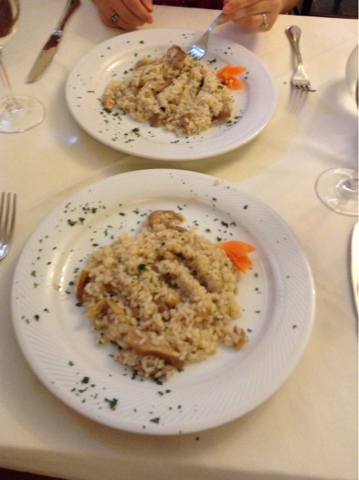We landed in Madagascar approximately 3 hours after we took off from Tanzania. Madagascar is the world's 4th largest island where 90% of the population live on less than just $2 a day. Due to isolation from mainland Africa, more than 80% of species are endemic though unfortunately approximately one third of Madagascar's mammals are either critically endangered or endangered.
 |
| Flying over Madagascar. |
Compared to a year and a half ago, the landscape is incredibly dry now. See below for a quick comparison.
 |
| January 2018 vs. September 2019. |
After a welcome dinner, we were off to bed... We were waking up early to drive 4 hours to Andasibe. Madagascar has a high level of endemic species and naturalists find Madagascar as a laboratory of evolution, like the Galapagos. Although Madagascar is known for birds and mammals, the reptiles, amphibians, insects and plants are just as unique. Madagascar is one of the priority conservation areas, especially for primates (only Brazil has more biodiversity in primates than Madagascar). While Madagascar is one of the primary conservation areas, over 90% of the island has been deforested. Driving along the road to Andasibe, you'll find chopped down eucalyptus trees everywhere you look. Locals get charcoal, which is then used for cooking, from eucalyptus trees and most locals drive to areas outside the capital "Tana" (the nickname for Antananarivo) because the bags of charcoal are 4-5 times more expensive in Tana. Even with buying expensive gasoline for a car or taking a public bus outside the city, the locals are still saving money than if they were to just buy a bag of charcoal in the capital city. Due to the high rates of deforestation, the government is actually trying to replant these fast growing trees.
 |
| Driving past local neighborhoods and villages on the way to Andasibe. |
The usually 4 hour drive to Andasibe ended up taking nearly 5 1/2 hours. Along the way, we hit a series of obstacles. First, we had to take a bypass instead of the main road because the pope is scheduled to arrive a few days after us. Therefore, traffic is more congested in the downtown... shocking since traffic seemed so congested as we navigated the steep, narrow marketplaces via car. Throughout the entire drive, we also encountered a ton of pot holes in the road. It's amazing how much worse they've gotten since we were here a year and a half ago! As this is the main road that connects the seaport to Tana (a 9 hour drive), trucks often carry heavier loads than they are supposed to and the city can't fix the roads fast enough so it just gets worse, especially once the heavy rains come. We also got backed up because there was an overturned truck on the side of the road. The drive is a series of switchbacks-- steep, winding roads that trucks have difficulty navigating with oversized loads. Even though the accident appeared to have occurred hours ago, the road is so remote that it can often take hours for help to arrive. Finally, a truck was able to move the overturned truck just enough to allow one lane of traffic around it at a time. Thankfully, there was a police officer directing traffic... Otherwise, we could have been there all day! There was a never ending line of cars going the other direction. After a brief stop at a local school, we finally arrived at our lodge nestled among palm gardens overlooking a forest lake.
 |
| Our lodge, located on the southern edge of Andasibe-Mantadia National Park. |
After a long, exhausting day, we ate our zucchini potage (apparently the terminology for a thick soup) and curry before heading off to bed. The following day, we had arranged a private tour to Lemur Island. You might remember that last year, I was disappointed that we didn't see ring tailed lemurs and this time, I wanted to do Lemur Island the way I was expecting it to go down the first time. Lemur Island currently has 6 lemur species, all of which have been rescued from households that were keeping lemurs as pets. Obviously since these lemurs have had human contact, they wouldn't be able to survive in the wild on their own so now they reside at a lemur sanctuary where they have access to land and all the leaves they want, plus food caretakers give them.
There are five families of lemurs... Mouse lemurs that are the smallest weighing at about 30 grams, indrids that are the largest of the lemurs and are specialized leapers weighing at about 20 pounds, sportive lemurs, true lemurs that are relatively well-studied because they're active during the day, and the aye-aye which is the most specialized primate about the size of a cat. Many lemurs have superstitions surrounding their origin and Malagasy people actually believe that all humans are descended from lemurs. The legend says that a man had two wives, but the wives fought a lot. One was turned into a ring tail lemur and the other was turned into a Sifaka lemur. The locals believe it is a bad omen to harm either species of lemur for this reason. However, some lemurs are killed due to bad superstitions, like the aye-aye. Locals believe that it is bad luck to have one point its finger at you, and aye-aye's are killed because of this. To see all the lemur species, we arrived to Lemur Island at 8am... We were the first ones there! We hopped into two canoes, setting off on a 2+ hour excursion around the five different islands here.
 |
| Early morning canoe on Lemur Island. |
Different islands have different species and as lemurs don't like water, they won't leave their designated island. Perhaps I am biased, but I find lemurs incredible. Madagascar is home to nearly 60 taxa of lemurs (including species, sub-species and populations from about 33 species across five families and 14 genera) all of which are endemic to Madagascar. In fact, Madagascar has the highest number of primate species after Brazil (which has 77 species but only 2 endemic genera and no endemic families.) Madagascar holds 20% of the world's primates and there are currently 113 species of lemur from Madagascar, 17 of which are extinct. New species are still being discovered, and primate researchers estimate that 10-20 new species of lemurs may be described over the next generation. As we sailed towards the furthest island, where the ring tailed lemurs are, we saw the mist burning off the water and heard the chirps of birds waking up.
On the way to see the ring tailed lemurs, we came across the brown lemur. Also called the true lemur, these lemurs are common in the central and northern parts of eastern Madagascar. It's fairly vocal, with a distinctive call. It gives a pig-like grunt which is often imitated by local guides. They're found in small to medium-sized groups which feed on fruits, leaves and flowers.
 |
| This brown lemur walking along a wooden log to come look at the canoe. |
 |
| A brown lemur walks through the grass, curious to check us out. |
 |
| Lemurs look oddly similar to dogs? |
 |
| Basking in the early morning sunshine. |
One of the brown lemurs jumped onto our canoe and though you're not allowed to touch the lemurs, the lemurs can do whatever they want to you. Is it good luck if a lemur poops on you? Because that happened... A lemur also decided it wanted a little canoe ride and would not get off my shoulder!
 |
| Yes, that is a lemur tail in my face. |
Finally, it was time to see the ring tailed lemurs. As we paddled closer to the island, I got giddy with excitement. Ring tailed lemurs are distinctive with their black eye patches and ringed tail... This lemur species is unmistakable for any of the others. They vocalize with a series of hoots and raucous chattering in groups and can live in groups of up to 30 in which females are dominant. Since Lemur Island only has rescued lemurs, however, there is only a family of five. These are the most terrestrial lemur, with leathery feet and long toes.
 |
| Approaching the island via canoe. |
 |
| Posing on the edge of the canoe. |
 |
| As we paddled closer to the island, the lemurs decided to hop on board. |
The ring-tailed lemurs were the most active species we saw. The entire time we were in the water near the island, they were jumping back and forth between land and our canoe. They jumped all over my camera lenses, going between my mom (behind me) and the front of the canoe, using my shoulder as a landing site whenever they took a leap.
 |
| Lemur photobomb. |
 |
| Three out of the five lemurs decided to hop on our canoe and on us. |
At one point, a lemur was holding onto my thumb while sitting on my telephoto lens!
We also watched them groom themselves and bask in the morning sun.
 |
| Ring tail lemurs in the early morning light. |
 |
| Selective coloring of a ring tail lemur. |
 |
| Sun bathing in the early morning. |
 |
| Grooming its tail. |
After photographing the ring tailed lemurs for nearly an hour, we paddled on towards the sifaka and two new red ruffed lemurs... But not before taking a final photo on the way out.
 |
| As we were paddling away, I saw the dark forest behind the ring tail lemur and knew it would make the perfect background. |
Navigating the misty waters, we also saw a group of wild duck.
 |
| Wild duck swimming around Lemur Island. |
When we paddled up to the island where the sifakas were, one of our guides hopped out to leave some banana and one of the sifakas came jumping out.
 |
| Sifaka leaping from tree to tree. |
 |
| Sifaka leaping towards the bananas in the natural forest lighting. |
Local Malagasy people named sifakas after their unique call that sounds like shif-auk. These primates spend the majority of their time in the trees, but don't get around the way most lemurs do. Instead, they remain upright and leap quickly by jumping with their elongated hind legs. They can even clear distances of over 30 feet! To move on the ground, they do a two-legged sideways hop that is the cutest thing you've ever seen.
Sifakas have gorgeous coloring. They have patches of black, white, gray and golden fur. They typically eat leaves, flowers, fruit, and tree bark and usually live in small family groups of 3-10 individuals.
 |
| Sifaka headshot. |
 |
| Sifaka finishing eating a banana. |
Lemurs can't move their eyes up and down or left and right, so if they want to see something they turn their head 180 degrees... A really primitive characteristic. If you look closely, you'll also notice that their noses are always wet. This is because they have a strong sense of smell and they are able to detect food long distance.
 |
| Sifaka at the water's edge. |
This island also had two red-ruffed lemurs, which are critically endangered due to deforestation, over-hunting by people for food and are trapped for the pet trade. These lemurs were a gift from a zoo in France and were introduced to Lemur Island one year ago. Red-ruffed lemurs spend almost all of their time high in the treetops and live in female-dominated family groups averaging in size from 2-16 individuals. Like the sifaka, these lemurs have gorgeous coloring.
 |
| Red-ruffed lemur coming to check us out. |
 |
| Red-ruffed lemur at the water's edge. |
A small bamboo lemur decided it didn't want to be left out, and came for some banana as well. Bamboo lemurs are found throughout the central and southern parts of eastern Madagascar and are reminiscent of a sportive lemur, but are active during the day. Unlike the brown lemurs, this species is not very vocal. They sometimes feed slowly but are highly active at other times. They're usually found alone or in small groups.
 |
| Bamboo lemur coming for a drink. |
 |
| Bamboo lemur with a banana. |
After photographing the sifakas, red-ruffed lemurs, and bamboo lemurs, we ended up completing a full circle back to island 1, which is the only island you can actually walk on to see the bamboo lemur, black and white ruffed lemur and brown lemur species.
 |
| Two brown lemurs on Island 1. |
 |
| Curious brown lemur. |
We took a short walk around, where the lemurs decided we looked like a great place to sit.
Here, we saw a black and white ruffed lemur... the second and final species of ruffed lemurs. This species is named for the "ruff" of long hair that runs from the ears along the cheeks to beneath their chin.
 |
| Black and white ruffed lemur. |
Black and white ruffed lemurs have a large, long tail and are similar in size and color to an indri (though indri have really short tails.) Black and white ruffed lemurs are normally found in small groups where the females are dominant. Once this house cat sized primate saw us, it came down from the tree... hanging upside down to check us out.
And, of course it decided to sit on us as well...
We then hopped back onto the canoe for the shortest canoe ride ever... not even a few feet across to the other side. By the time we had left Lemur Island, I had taken 831 photographs just on my two cameras! We got into the car and drove about 5 minutes away to another site to see mossy leaf tailed geckos and elephant ear chameleons.
 |
| We passed huge plant leaves on the way to see the chameleons. |
 |
| Hundreds of caterpillars piled together on tree bark. |
 |
| Elephant ear gecko. |
 |
| Spot the mossy leaf tailed geckos... masters of camouflage. |
After a quick lunch break at the hotel with more potage (this time pumpkin), vegetable lasagna and a chocolate salted caramel cake, it was time to head back out to nearby Analamazaotra National Park to try to see lemurs in the wild... something that would be difficult because lemurs are known to sleep in the afternoon. The park actually closes at 4pm every day because the lemurs are typically asleep from 4pm until 6am when the park opens. Analamazaotra National Park is the most popular park within Andasibe Mantadia. It is where most people come to find the indri, Madagascar's largest living lemur species (there was once a lemur the size of a gorilla that is now extinct.) I didn't have high expectations, as everyone kept telling me that the lemurs would be hard to find when they are sleeping. My local guide Alan advised me that he sent a tracker off ahead of us to try to locate various lemur groups throughout the forest. We had two other guides with us as well. Still, I didn't want to get my hopes up.
We walked for over an hour on the main cobbled path occasionally climbing uneven stairs without a single sighting of an animal. No birds, insects, reptiles, and no lemurs. My guide did point out orchids which are starting their seasonal bloom, iris, a plant that is used for tea leaves when you have a stomach ache, and some other local flora and fauna.
 |
| I loved the lighting on this flower! |
As we turned the corner, there was one tourist with her guide climbing back down the mountain and one of my guides stopped them to ask some questions. They left and he turned to me and said "we're getting close". Close to what? He darted off into the thick bush and pointed high up to the treetops. Barely visible, I caught sight of my first indri. I barely had time to take out my telephoto lens before the group started leaping from tree to tree. We practically ran over twigs, rocks, in between trees that you had to turn sideways to fit through the opening, ducking under branches, hiking up, down, and every which way. Finally, the group of indri stopped to eat and I was able to stand up, looking high in the canopy to photograph them.
 |
| Indri high in the treetops. |
 |
| Another indri eating high in the treetops. |
My guides were playing a sound recording of the indri's call to try to get them to vocalize, but they were more interested in eating. I didn't care... I was just happy to find them still active after everyone told me the lemurs would be sleeping by now. Indri can eat 2 pounds of leaves per day but only come down onto the ground 2-3 times a month to eat clay which neutralizes the alkaline in their food.
 |
| Snack break! |
The indri are unique because unlike other lemurs, they have a very short tail that appears stump-like. All indris have yellow eyes and large black ears and the females weigh, on average, more than the males. While their coloring is variable, their size, short tail, and bushy ear tufts make this species unmistakable. Like the sifaka, the indris jump between tree to tree and spend much of their time up high to escape the predatory fossa (a cat-like carnivorous mammal endemic to Madagascar.) Indri typically live in small groups of 2-6. Another fact I find interesting about the indri is that they are monogamous breeders, so there is no interbreeding like with lion populations.
Here in Analamazaotra, there are approximately 65 family groups but only 2 of these 65 are used to people... the others still hide.
As I was photographing the indri, a group of local Malagasy people came by and stared in awe at my camera. They even asked if they could take a photo with me because they had never seen such a huge telephoto lens before! I'm definitely glad I brought it on the hike, but shooting upwards, high into the treetops with a 150-600mm lens is no easy task. Arms shaking, we eventually resumed our hike. We saw a bug and two collared birds.
Suddenly, my guide took me off trail again.
After a bit of hiking in the dense rainforest, we came across a family of sifaka... one of which had a very young baby (unfortunately I didn't have time to get a photo before the group started moving again.)
 |
| Golden sifaka among the trees. |
 |
| Golden sifaka eating in a tree. |
We rushed back onto the main path and watched as the sifakas flew over the path from treetop to treetop. As we continued on, we came across Eastern gray bamboo lemurs.
 |
| Screenshot from a video I took. |
On the way back to the car, we saw a mossy leaf tailed gecko and a tree boa. Tree boas hibernate in trees and are the main predators of mouse lemur. Nearly 5 miles of hiking and 23 flights worth of stairs later, I left the park a very happy camper. The following morning, we drove through Andasibe in mist so thick, you'd think you were in a horror movie. We couldn't even see a few inches in front of us, though our drivers probably could have driven this road with their eyes closed.
 |
| Misty morning at Vakona Forest Lodge. |
After 4 1/2 hours on the road past the villages, the rice paddies, the local markets, and a ton of traffic, we arrived back in Tana for our flight to Cape Town. As we took off, I let out a big sigh of relief. We made it. There was no cyclone this time around. No evacuation. Madagascar redemption.
Thanks for reading about my African adventures… Stay tuned for what’s to come and be sure to hit the subscribe button to be notified of new posts! As always, follow my Instagram @elissatitle for more pics.




































































While I know you were most excited to see and photograph ring tailed lemurs, that red-ruffed lemur was sublime. The screen grab of the primate mid-air was also gorgeous.
ReplyDeleteThis post makes me happy! Just seeing you both with animals atop your heads is good enough but the rest is fabulous.
ReplyDelete